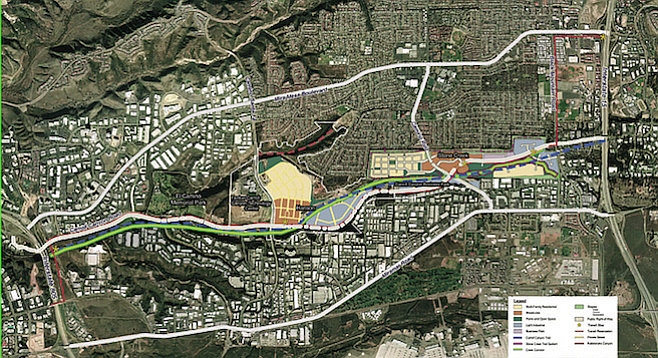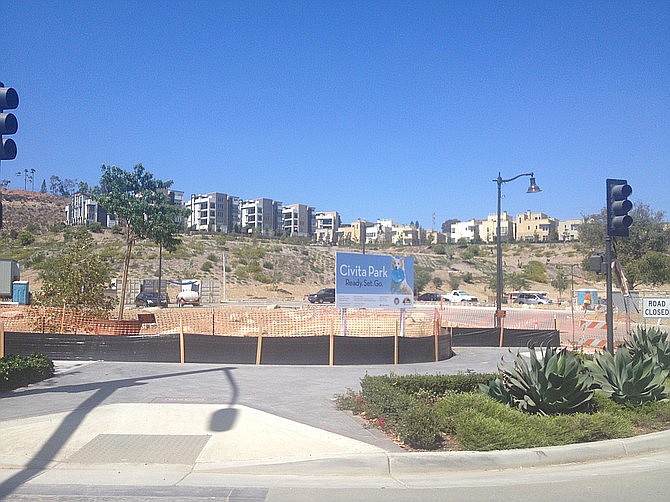 Facebook
Facebook
 X
X
 Instagram
Instagram
 TikTok
TikTok
 Youtube
Youtube

The decades-old Vulcan mining operation on nearly 300 acres of Carroll Canyon will be a huge housing project if developers' lobbying efforts are successful.
Bordered by Mira Mesa Boulevard, Miramar Road, Camino Santa Fe, and Black Mountain Road, the significant size of the proposed project is the topic of much community concern.
The initial 2005 proposal for Stone Creek was for 9800 residential units. A more modest plan of 4445 units is currently proposed along with 1.2 million square feet of commercial and industrial space.
Mira Mesa planning chair Jeff Stevens said recently, “Besides traffic issues, parks are a major concern. People need an active park to play in, not the passive park Vulcan proposes. The population is 80,000 in our community plan and we only have two community parks when we should have three. We’ll be approaching 100,000 people after this project.”
Stevens said the planning group made traffic recommendations in January 2016 after reviewing a 2015 Vulcan traffic study.
“If Vulcan did all the things we recommended, it would satisfy the planning group. Vulcan hasn’t agreed to do them. On some of the needed traffic improvements they say they’ll make a contribution instead of doing the actual work. It doesn’t do us any good to have a contribution for a road that needs to be there because of their project.”
While Vulcan is extending Carroll Canyon Road and some other improvements, Stevens said that a contribution on other things without any idea of when work will be completed isn’t enough and that Vulcan needs to do the work and get reimbursed later, if needed.
According to Stevens, “The next step for Vulcan is to complete the [environmental impact report]. They were talking about having it completed this fall and then going to the planning commission but Vulcan said the report was delayed because of a lawsuit.”
City spokesman José Ysea said that there isn’t any hold-up via litigation and that Vulcan is currently preparing the required technical studies. Once completed, he said the city will prepare the environmental impact report. It should be noted that the technical studies prepared by Vulcan will be what the city relies upon to prepare the report.
Besides living next door to the proposed Stone Creek development in Scripps Ranch, Craig Jones has 18 years' experience as a planner with different San Diego municipalities.
“Living in Scripps Ranch and having to drive Mira Mesa Boulevard is a horrible experience," says Jones. "I avoid it even at off-peak hours. During peak hours, it’s just awful. I don’t see how Mira Mesa can handle the extra traffic.”
Jones asked if the project was being sold as “transit-oriented,” which he said is a misnomer with more and more traffic being dumped on an already stressed area. His guesstimate via the SANDAG traffic generation rate list is that about 35,000 to 50,000 additional trips per day would be generated from the development.
Stevens said, “Stone Creek is being planned as a transit-oriented development, but they have not asked for traffic mitigation to be reduced because of it. There are two transit stops in their master plan, which will initially have bus service and eventually a trolley stop if the city follows through with its long-term plans. We do have a concern with their phasing [through 2030]. If you want people to use transit instead of cars, the transit needs to be in place from the beginning and very reliable. As currently planned, they will build the lower-density parts of the project on the east and west first, and the higher-density core last. For it to really work as transit-oriented development you need the higher-density core and transit stops first.”
Jones also commented on the negative impact that money and influence has had on the governmental process. He said if you ask most anyone in government who their customer is, their response will be “the developers” instead of the real customer, “the public interest.”
When it comes to money and influence, the Stone Creek development has put its money where its mouth is. According to lobbying disclosure forms, super-lobbyist Paul Robinson (Hecht Solberg Robinson Goldberg and Bagley) is at the head of the Stone Creek approval charge. Robinson came out of former mayor Pete Wilson’s office after spending years with the city attorney’s office. Also joining the crusade is Rath Miller, led by Phil Rath, a former aide to ex-mayor Jerry Sanders.

According to Stevens, Robinson has likely been lobbying for Stone Creek since 2006, and Rath since at least 2013. Palms have been pressed all the way to the top in the mayor’s office, development services, planning department, city attorney’s office, Parks and Recreation department, and the offices of council districts 1, 5, and 6. Campaign contributions and fundraising efforts to the tune of more than $700K (2012–2016) were bestowed on those who were lobbied about the Stone Creek development as well as those in council districts next door to the project area, including that of District 7 with their own similar Vulcan mega-development underway in Mission Valley.
Jeff Powell from councilmember Scott Sherman’s District 7 office said that once the Mission Valley project is completed, it will deserve to be defined as “transit-oriented.”
While driving through this Mission Valley development, I saw streets lined with cars, condominiums, passive parks, electric vehicle stations, but not one bus stop. I asked a construction worker if a bus stop was in the works. He laughed, “Oh no, no way!”
Outside the development, I found one bus stop across the street on Mission Valley Road. There is also a trolley station within a 10–20 minute walk.
Repeated requests for comment went unanswered from Vulcan and others associated with the project.


The decades-old Vulcan mining operation on nearly 300 acres of Carroll Canyon will be a huge housing project if developers' lobbying efforts are successful.
Bordered by Mira Mesa Boulevard, Miramar Road, Camino Santa Fe, and Black Mountain Road, the significant size of the proposed project is the topic of much community concern.
The initial 2005 proposal for Stone Creek was for 9800 residential units. A more modest plan of 4445 units is currently proposed along with 1.2 million square feet of commercial and industrial space.
Mira Mesa planning chair Jeff Stevens said recently, “Besides traffic issues, parks are a major concern. People need an active park to play in, not the passive park Vulcan proposes. The population is 80,000 in our community plan and we only have two community parks when we should have three. We’ll be approaching 100,000 people after this project.”
Stevens said the planning group made traffic recommendations in January 2016 after reviewing a 2015 Vulcan traffic study.
“If Vulcan did all the things we recommended, it would satisfy the planning group. Vulcan hasn’t agreed to do them. On some of the needed traffic improvements they say they’ll make a contribution instead of doing the actual work. It doesn’t do us any good to have a contribution for a road that needs to be there because of their project.”
While Vulcan is extending Carroll Canyon Road and some other improvements, Stevens said that a contribution on other things without any idea of when work will be completed isn’t enough and that Vulcan needs to do the work and get reimbursed later, if needed.
According to Stevens, “The next step for Vulcan is to complete the [environmental impact report]. They were talking about having it completed this fall and then going to the planning commission but Vulcan said the report was delayed because of a lawsuit.”
City spokesman José Ysea said that there isn’t any hold-up via litigation and that Vulcan is currently preparing the required technical studies. Once completed, he said the city will prepare the environmental impact report. It should be noted that the technical studies prepared by Vulcan will be what the city relies upon to prepare the report.
Besides living next door to the proposed Stone Creek development in Scripps Ranch, Craig Jones has 18 years' experience as a planner with different San Diego municipalities.
“Living in Scripps Ranch and having to drive Mira Mesa Boulevard is a horrible experience," says Jones. "I avoid it even at off-peak hours. During peak hours, it’s just awful. I don’t see how Mira Mesa can handle the extra traffic.”
Jones asked if the project was being sold as “transit-oriented,” which he said is a misnomer with more and more traffic being dumped on an already stressed area. His guesstimate via the SANDAG traffic generation rate list is that about 35,000 to 50,000 additional trips per day would be generated from the development.
Stevens said, “Stone Creek is being planned as a transit-oriented development, but they have not asked for traffic mitigation to be reduced because of it. There are two transit stops in their master plan, which will initially have bus service and eventually a trolley stop if the city follows through with its long-term plans. We do have a concern with their phasing [through 2030]. If you want people to use transit instead of cars, the transit needs to be in place from the beginning and very reliable. As currently planned, they will build the lower-density parts of the project on the east and west first, and the higher-density core last. For it to really work as transit-oriented development you need the higher-density core and transit stops first.”
Jones also commented on the negative impact that money and influence has had on the governmental process. He said if you ask most anyone in government who their customer is, their response will be “the developers” instead of the real customer, “the public interest.”
When it comes to money and influence, the Stone Creek development has put its money where its mouth is. According to lobbying disclosure forms, super-lobbyist Paul Robinson (Hecht Solberg Robinson Goldberg and Bagley) is at the head of the Stone Creek approval charge. Robinson came out of former mayor Pete Wilson’s office after spending years with the city attorney’s office. Also joining the crusade is Rath Miller, led by Phil Rath, a former aide to ex-mayor Jerry Sanders.

According to Stevens, Robinson has likely been lobbying for Stone Creek since 2006, and Rath since at least 2013. Palms have been pressed all the way to the top in the mayor’s office, development services, planning department, city attorney’s office, Parks and Recreation department, and the offices of council districts 1, 5, and 6. Campaign contributions and fundraising efforts to the tune of more than $700K (2012–2016) were bestowed on those who were lobbied about the Stone Creek development as well as those in council districts next door to the project area, including that of District 7 with their own similar Vulcan mega-development underway in Mission Valley.
Jeff Powell from councilmember Scott Sherman’s District 7 office said that once the Mission Valley project is completed, it will deserve to be defined as “transit-oriented.”
While driving through this Mission Valley development, I saw streets lined with cars, condominiums, passive parks, electric vehicle stations, but not one bus stop. I asked a construction worker if a bus stop was in the works. He laughed, “Oh no, no way!”
Outside the development, I found one bus stop across the street on Mission Valley Road. There is also a trolley station within a 10–20 minute walk.
Repeated requests for comment went unanswered from Vulcan and others associated with the project.
Comments